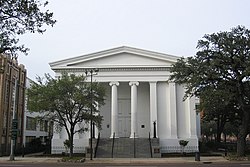Government Street Presbyterian Church
|
Government Street Presbyterian Church
|
|

Government Street Presbyterian Church in 2007.
|
|
| Location | 300 Government Street Mobile, Alabama, USA |
|---|---|
| Coordinates | 30°41′22″N 88°2′37″W / 30.68944°N 88.04361°WCoordinates: 30°41′22″N 88°2′37″W / 30.68944°N 88.04361°W |
| Built | 1836-37 |
| Architect | James Gallier, James Dakin, and Charles Dakin |
| Architectural style | Greek Revival |
| NRHP Reference # | 92001885 |
| Significant dates | |
| Added to NRHP | October 5, 1992 |
| Designated NHL | October 5, 1992 |
Government Street Presbyterian Church in Mobile, Alabama is one of the oldest and least-altered Greek Revival church buildings in the United States. The architectural design is by James Gallier, Sr., James H. Dakin, and Charles Dakin. The trio also designed Barton Academy, four blocks down Government Street to the west. Government Street Presbyterian reflects the influences of Ithiel Town, Minard Lafever, and Andrew Jackson Downing. It was declared a National Historic Landmark in 1992.
The Government Street Presbyterian Church congregation was formally organized in 1831. It initially met in a frame building on Government Street. A lot at the corner of Government and Jackson Street was purchased for $10,000 in the spring of 1835. Local millionaire and church trustee, Henry Hitchcock, ran an ad in the Mobile Daily Register in December 1835 that advertised for builders. Hitchcock served on the church's building committee and financed much of the construction to come. The drawings and specifications had already been provided by Gallier and Dakin.
Construction of the new brick edifice commenced on February 13, 1836. The masonry had been completed by March 1837, with one of the architects, Charles Dakin, being married within the sanctuary on March 22, 1837. In June that year the newspaper announced that pews were now being rented. The construction costs eventually totaled $60,000, with $40,000 of that having gone to the mason, Thomas James.
A storm toppled the steeple in 1852, with little damage done to the rest of the structure. Afterward a committee was formed to determine if it was desirable to rebuild it, and the ladies of the church formed a "steeple society" to raise the funds for the construction. The committee later decided to recommend that the congregation not replace it. A cypress floor was installed over the existing stone floor in the basement level in 1869. In 1893 the pulpit was altered and the doors were removed from the pews. In 1898 electric lighting was introduced, replacing the gas fixtures.
...
Wikipedia

